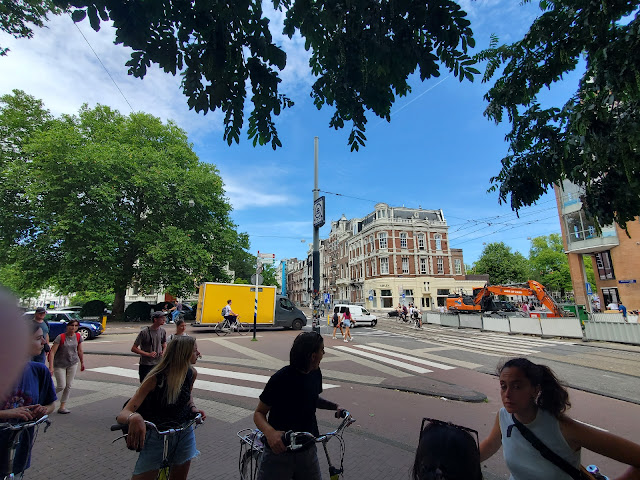Impressions of Dutch Bicycling - Utrecht
Arriving in the Netherlands' fourth most populous city, Utrecht provided me with perhaps the clearest comparison between Dutch and Danish bicycling approaches and cultures. Immediately, I noticed the difference between how space is utilized in support of bicycling in these two countries. Of course, there are cycle tracks in the Netherlands, but there are far more roads where bikes, cars, and pedestrians intermingle in an unchoreographed, but nevertheless orderly, system of transport. Pedestrians are not really supposed to be on the shared road space but my experience showed they will cross the road at will or step off a sidewalk into the road when the sidewalk is blocked off or choked down in space by the numerous parked bikes. The roads where cars and bicycles share space are called fietspad or "cycle track, paths, roads". Here cars can travel on the same road but the law stipulates that bikes have priority within the traffic flow. Hence, I often biked alongside cars but the other important regulation is that these are slower speed areas. The built environment, such as speed bumps and signage, further encourages drivers to slow down and yield to bicyclists. As a result, I never felt in danger of being cut off or even clipped by a car when I biked down these roads.
 |
| A redesigned street that includes mixed space for car and bicycle usage; bikes prioritized |
 |
| Typical bike parking garage found in Utrecht, Netherlands |
In terms of how each country bikes, the segregated spaces employed by the Danish approach encourage people to understand a rules-based system, where one should be in space, timing, and how that influences your movement through traffic. In contrast, the Dutch approach relies on awareness of space and trust between individuals. Everyone is looking at everyone else as they travel. When I biked down a fietspads, crossing pedestrians would look at me to gauge my intent, my speed, and my direction, making that quick judgment about whether they would continue to cross or wait until I passed. Drivers demonstrated this behavior as well when the bike had priority.
Honestly, I am not sure in which context I felt safer. I would probably lean toward the Dutch approach simply because it is more based on the behavior of all the individuals to be aware of their space and which transport mode has priority to travel. But I did start becoming accustomed to biking in a system with clear lanes for cars, bikes, and pedestrians as is typical in the Danish system.
In how I think these approaches would work best in the United States, I feel the Danish approach is where we need to start. The U.S. absolutely lacks the cultural elements of spatial awareness that make the Dutch approach work and segregating space in our urban cores is where I believe we should start. Cars already kill enough people each year and our vehicle sizes do not appear to be shrinking anytime soon, nor do our speed limits. Even if we did impose speed limit reductions, without the corresponding infrastructure changes to the street to calm traffic, there is plenty of evidence and data to show that drivers will continue to speed and violate the limit. To encourage biking in the U.S. people need to feel safe, and telling them, "just make eye contact with the pedestrians and other drivers" is unlikely to assuage anyone of the risks overnight. That kind of culture is developed over time and it has little foundation in the country at the moment. Perhaps in low-density and less populated areas, the fietspad concept could be experimented with, but I struggle to see how many U.S. drivers would be able to accept that the car is given secondary priority to bicyclists.



Comments
Post a Comment